You know you need to pay attention to your blind spot in your vehicle. Truck drivers do too but the blind spots in semi-trucks are much larger. Knowing more about their blind spots and where they are located can help keep you safe on the road.
More awareness of a truck’s blind spots can make you feel more confident on the road and help you avoid a potential truck accident. Englander Peebles is a personal injury law firm that provides truck accident legal assistance. In this article, we detail the blind spots of a semi-truck and what you can do if you or a loved one get in an accident with a semi-truck.

Where Are the Blind Spots On Semi Trucks?
Semi-trucks have four blind spots at the front, back, left, and right sides. Here is what to know about each one:
Front Blind Spot
The elevated positioning of a truck driver means that they have a huge blind spot in front of the semi-truck. This blind spot runs from the grill of the truck to 20 feet in front, generally about the length of a pickup truck.
It may not always be possible to avoid this positioning when traffic is bumper-to-bumper but when traffic is flowing, be sure you stay far enough ahead of the truck so the trucker sees your vehicle.
Rear Blind Spot
Truck drivers cannot see anything that is 30 feet behind the trailer. It stands to reason that you should never tailgate these vehicles because the truck driver won’t be able to see you. Do your best to stay visible by staying at least three car lengths behind any large truck.
Left Blind Spot
While you should pass trucks on the left side, there is a blind spot to be aware of in this area. You will not be visible in the truck’s side mirrors if your vehicle is in the area just behind the cab or halfway alongside the length of the trailer. If you need to pass a truck, make sure that you quickly pass and move ahead rather than staying where they can’t see you.
Right Blind Spot
By far, the worst place to be when driving near a semi-truck is on the right side. This blind spot runs from the cab of the truck to halfway alongside the trailer in both the adjacent lane and the next lane over. If you can see the truck driver directly through the windows of the cab or in their side mirror, then the driver can see you.
What to Know About Truck Accident Claims When Blind Spots Are Involved
Driving a truck requires a great deal of training before a truck driver can get their commercial driver’s license (CDL). Truck drivers learn how to avoid risks on the road during this training, including being aware of their blind spots.
While truck drivers are highly trained, if they fail to pay attention to the four blind spots and cause a truck accident, they may be liable. If you were in an accident with a truck that merged into your lane because the driver failed to check their blind spot, you should speak with a Florida truck accident lawyer to learn more about your legal options.
Steps to Take After Truck Accidents in Florida
After a truck accident that was caused by a truck driver failing to pay attention to their blind spots, the steps you take are imperative for your recovery of compensation. In order to file truck accident claims, you will need to have evidence that shows the truck driver was negligent.
This can be a huge challenge without a Florida truck accident lawyer to help you. One reason truck accident legal assistance is necessary for truck accident claims is due to Florida’s no-fault insurance laws. You will need to file your claim with your insurer first, even if you did not cause the crash.
Another reason is due to the modified comparative negligence laws in the state. This means you could be assigned some of the fault for your injuries in the wreck. Trucking companies and their insurers will look for ways to claim that you were negligent. Since you can only seek a lawsuit for severe injuries or high medical costs, this tactic is used to minimize your payout.
Make sure that you have an advocate on your side who knows about trucking regulations and your legal rights. Contact Englander Peebles to get truck accident legal assistance.


